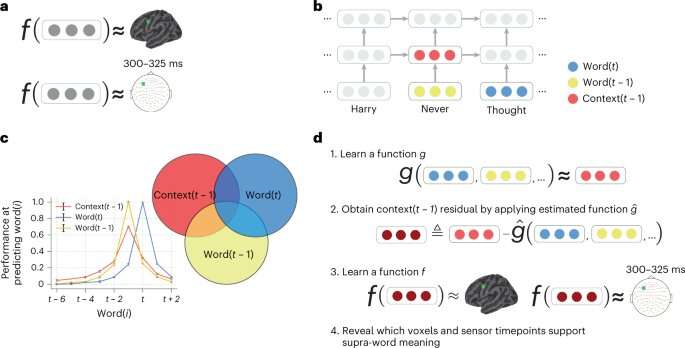
Humans accomplish a phenomenal amount of tasks by combining pieces of information. We perceive objects by combining edges, categorize scenes by combining objects, interpret events by combining actions, and understand sentences by combining words.
But researchers don’t yet have a clear understanding of how the brain forms and maintains the meaning of the whole—such as a sentence—from its parts. Carnegie Mellon University researchers in the School of Computer Science’s (SCS) Machine Learning Department (MLD) have shed new light on the brain processes that support the emergent meaning of combined words.
Mariya Toneva, a former MLD Ph.D. student now faculty at the Max Planck Institute for Software Systems, worked with Leila Wehbe, an assistant professor in MLD, and Tom Mitchell, the Founders University Professor in SCS, to study which regions of the brain processed the meaning of combined words and how the brain maintained and updated the meaning of words.
This work could contribute to a more complete understanding of how the brain processes, maintains and updates the meaning of words, and could redirect research focus to areas of the brain suitable for future wearable neurotechnology, such as devices that can decode what a person is trying to say directly from brain activity. These devices can help people with diseases like Parkinson’s or multiple sclerosis that limit muscle control.
Toneva, Mitchell and Wehbe used neural networks to build computational models that could predict the areas of the brain that process the new meaning of words when they are combined. They tested this model by recording the brain activity of eight people as they read a chapter of “Harry Potter and the Sorcerer’s Stone.”
The results suggest that some regions of the brain process both the meaning of individual words and the meaning of combined words, while others process only the meanings of individual words. Crucially, the authors also found that one of the neural activity recording tools they used, magnetoencephalography (MEG), did not capture a signal that reflected the meaning of combined words.
Since future wearable neurotechnology devices might use recording tools similar to MEG, one potential limitation is their inability to detect the meaning of combined words, which could affect their capacity to help users produce language.
The team’s work builds on past research from Wehbe and Mitchell that used functional magnetic resonance imaging to identify the parts of the brain engaged as people read a chapter of the same Potter book. The result was the first integrated computational model of reading, identifying which parts of the brain are responsible for such subprocesses as parsing sentences, determining the meaning of words and understanding relationships between characters.
The findings are published in the journal Nature Computational Science.
Mariya Toneva et al, Combining computational controls with natural text reveals aspects of meaning composition, Nature Computational Science (2022). DOI: 10.1038/s43588-022-00354-6
Citation:
Combining computational controls with natural text sheds new light on how the brain processes language (2022, November 29)
retrieved 29 November 2022
from https://techxplore.com/news/2022-11-combining-natural-text-brain-language.html
This document is subject to copyright. Apart from any fair dealing for the purpose of private study or research, no
part may be reproduced without the written permission. The content is provided for information purposes only.
Stay connected with us on social media platform for instant update click here to join our Twitter, & Facebook
We are now on Telegram. Click here to join our channel (@TechiUpdate) and stay updated with the latest Technology headlines.
For all the latest Technology News Click Here
For the latest news and updates, follow us on Google News.
